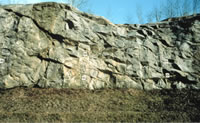An unconformity is a surface between successive strata in the bedrock that represents a missing interval in the geologic record of time, and is produced either by an interruption in deposition or by the erosion of depositionally
continuous strata followed by renewed deposition.
 Groundwater contractors have long realized the significance of the abundance of fractures and other types of openings
in the bedrock immediately below the bedrock surface as often these zones provide good well yields. Further, the fractures and solution cavities are commonly connected so as to provide conduits for the movement of groundwater even in
the densest rock.
Groundwater contractors have long realized the significance of the abundance of fractures and other types of openings
in the bedrock immediately below the bedrock surface as often these zones provide good well yields. Further, the fractures and solution cavities are commonly connected so as to provide conduits for the movement of groundwater even in
the densest rock.
Pictured here is fractured rock located in the Mirror Lake, New Hampshire area. Photo courtesy USGS.
The presence of so many openings at the bedrock surface is related to the erosive forces of the elements of nature, which can weather and break down any type of geologic material that is exposed to subaerial conditions. Likewise, the mechanical disintegration
of the bedrock surface through time releases some of the confining pressure that once existed on the underlying rock, allowing it to warp upwards and, consequently, fracture under the tension of warping. Many horizontal fractures can
be developed in this way. Other fractures can develop parallel to the surface of the exposed rock formation, especially if it is homogeneous. The process by which these surface fractures develop is termed exfoliation. All fractures and joints
are widened by frost wedging, heating and cooling, and wetting and drying. The ultimate effect is to make the upper part of the bedrock more permeable as time goes on. Locally, however, enough fine detritus is produced from the weathering of
the bedrock to plug the wider openings and reduce permeability.
A surface that has been exposed for a long period of time and, consequently, one which commonly contains a zone of permeability, is termed an unconformity. There are four types of unconformities. Disconformities are those that occur between
sedimentary rocks. Nonconformities are parallel nonconformities between sedimentary and igneous rocks. Angular conformities are those with parallel sedimentary layers that have been deposited over sharp, angular sediments. Paraconformities have
no eroded surface and are recognized when rocks of a particular age are absent. Generally, an unconformity is detected by noting a difference in the dip of the two superimposed rock sequences, by irregularities in the contact surface, by interruptions
in the formations of either sequences, or by a weathering condition of the underlying sequence near the contact.
Many unconformities are immediately overlain by a sequence of gravel of nonmarine origin or of shallow water marine origin. The gravels together with the weathered zone beneath the unconformity can make a prolific aquifer.
G.B. Maxey and J.E. Hackett (1963, Applications of geohydrologic concepts in geology, Journal of Hydrology 1, no. 1: 39-40) noted the importance of the weathered zone in the top of Precambrian crystalline rocks in the northern Rocky Mountains
and the abundance of springs along its outcrop in the Owl Creek and Big Horn mountains of Wyoming.
Another example of an unconformity is the weathered zone of the Galena and Platteville dolomite formations in Wisconsin and Illinois that is noted for its water-yielding properties. These weathered zones are developed where the dolomites are covered with
glacial drift today, indicating that they were exposed and weathered prior to the Pleistocene ice ages.
The most important unconformity known to contractors and the most evident one is the present land surface. But, commonly at least one or two other unconformities are present in the geologic column of many areas. If these erosion
surfaces are sufficiently near the present land surface to have been flushed of their original water and to contain fresh water, they should be carefully prospected.
Most geologic reports discuss the types of unconformities present in the area and their relationship to the present rocks and land surface, and are commonly illustrated by the inclusion of geologic cross-sections. In the Illinois Basin, for example, the
geologic column contains eight major unconformities. Near the margin of the basin, most of these unconformities have been flushed and many of them are currently prolific producers of fresh water.
The above information is excerpted in large part from Chapter 20 of the 1999 NGWA Press publication, Ground Water Hydrology for Water Well Contractors.